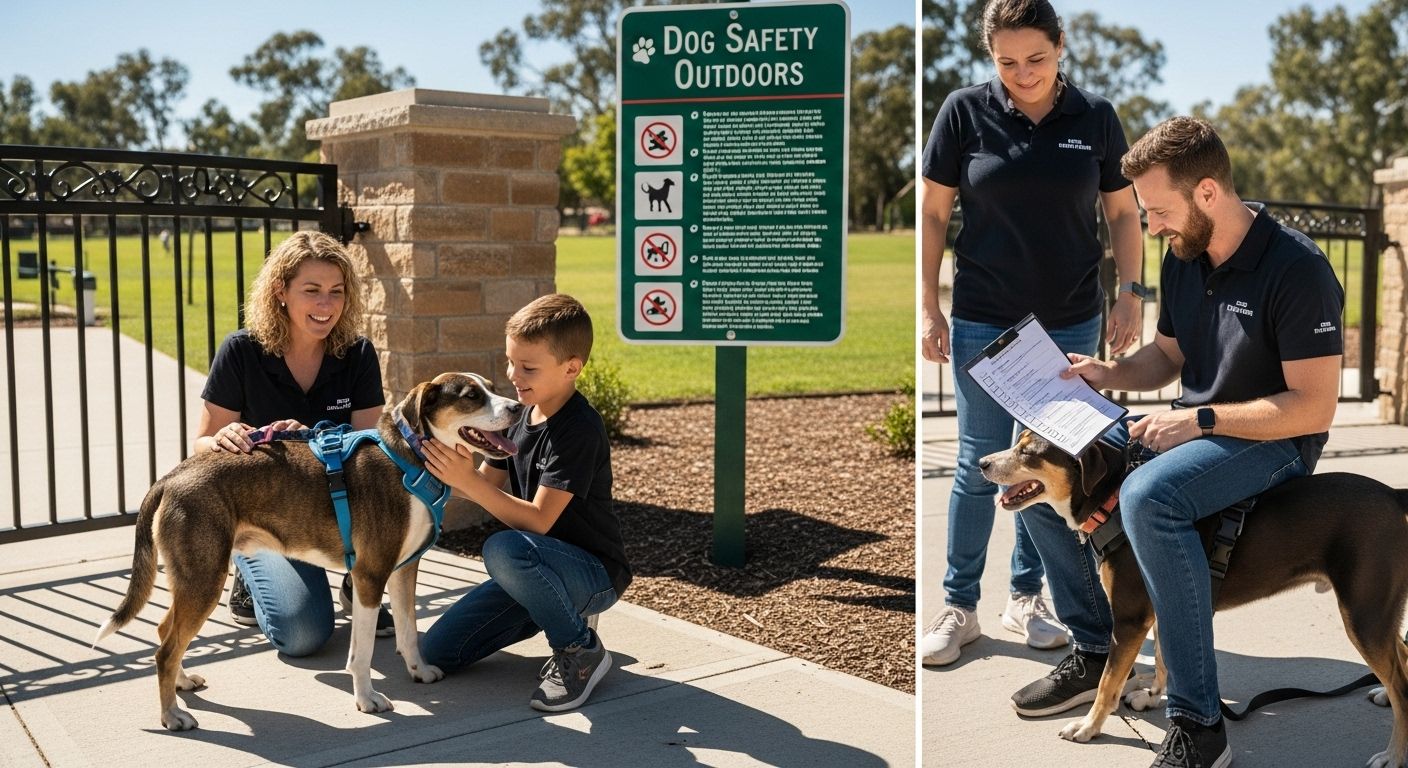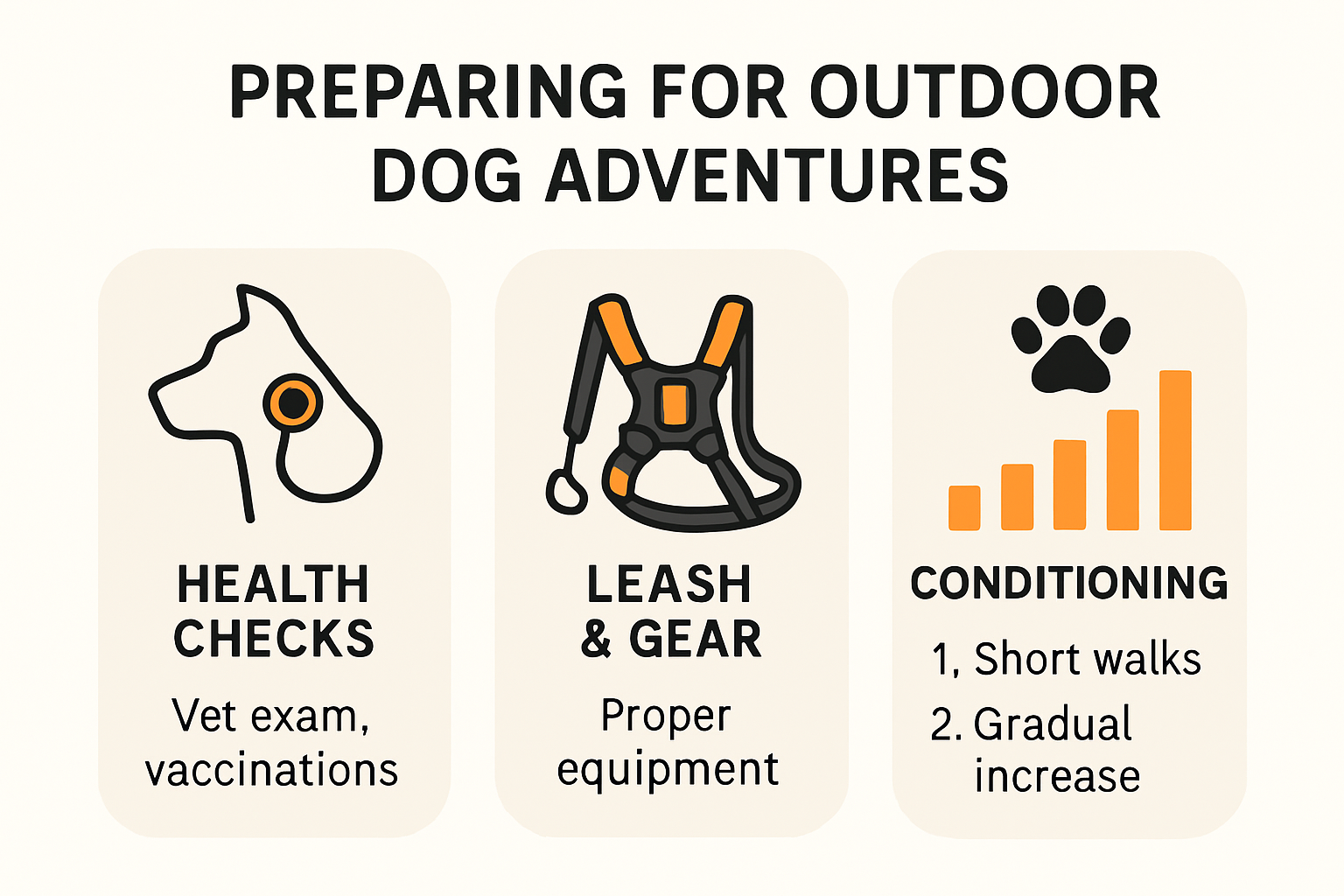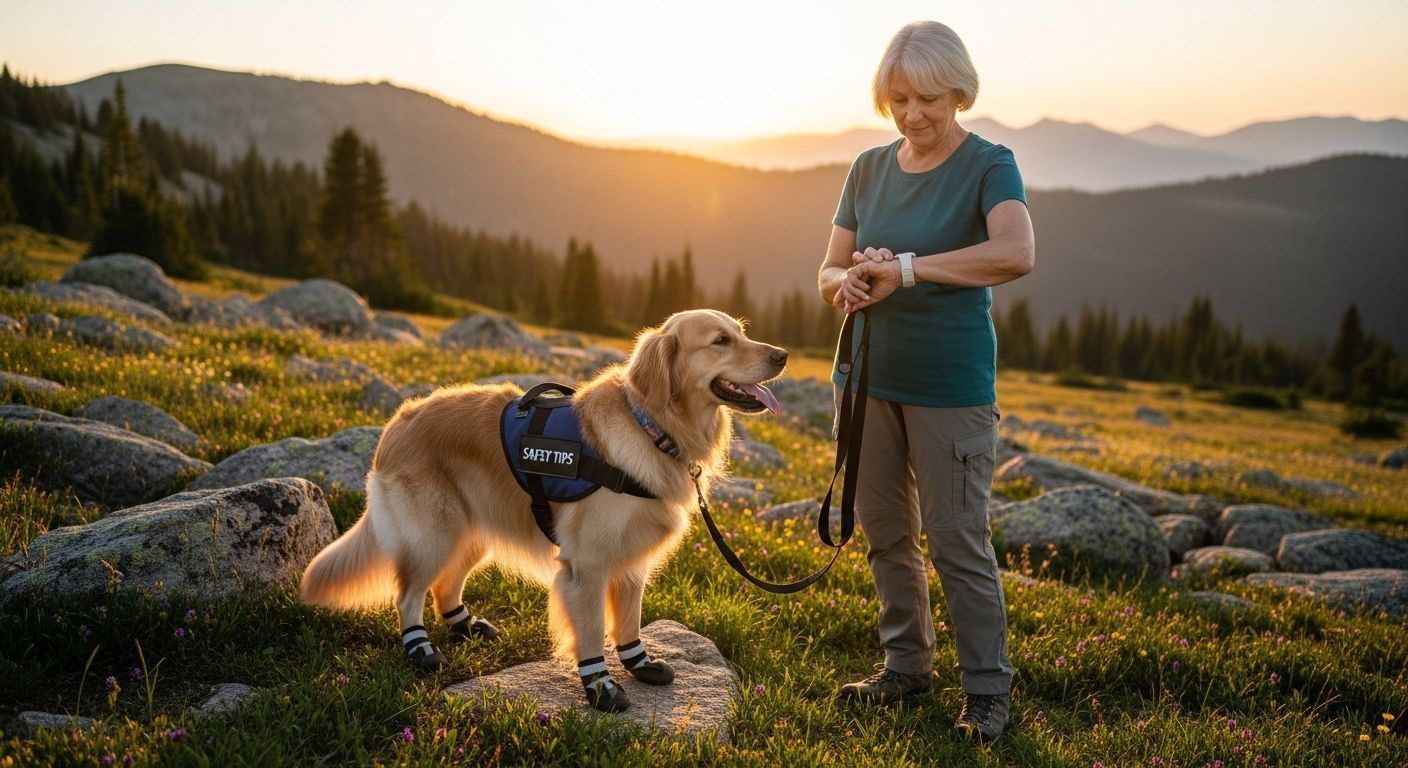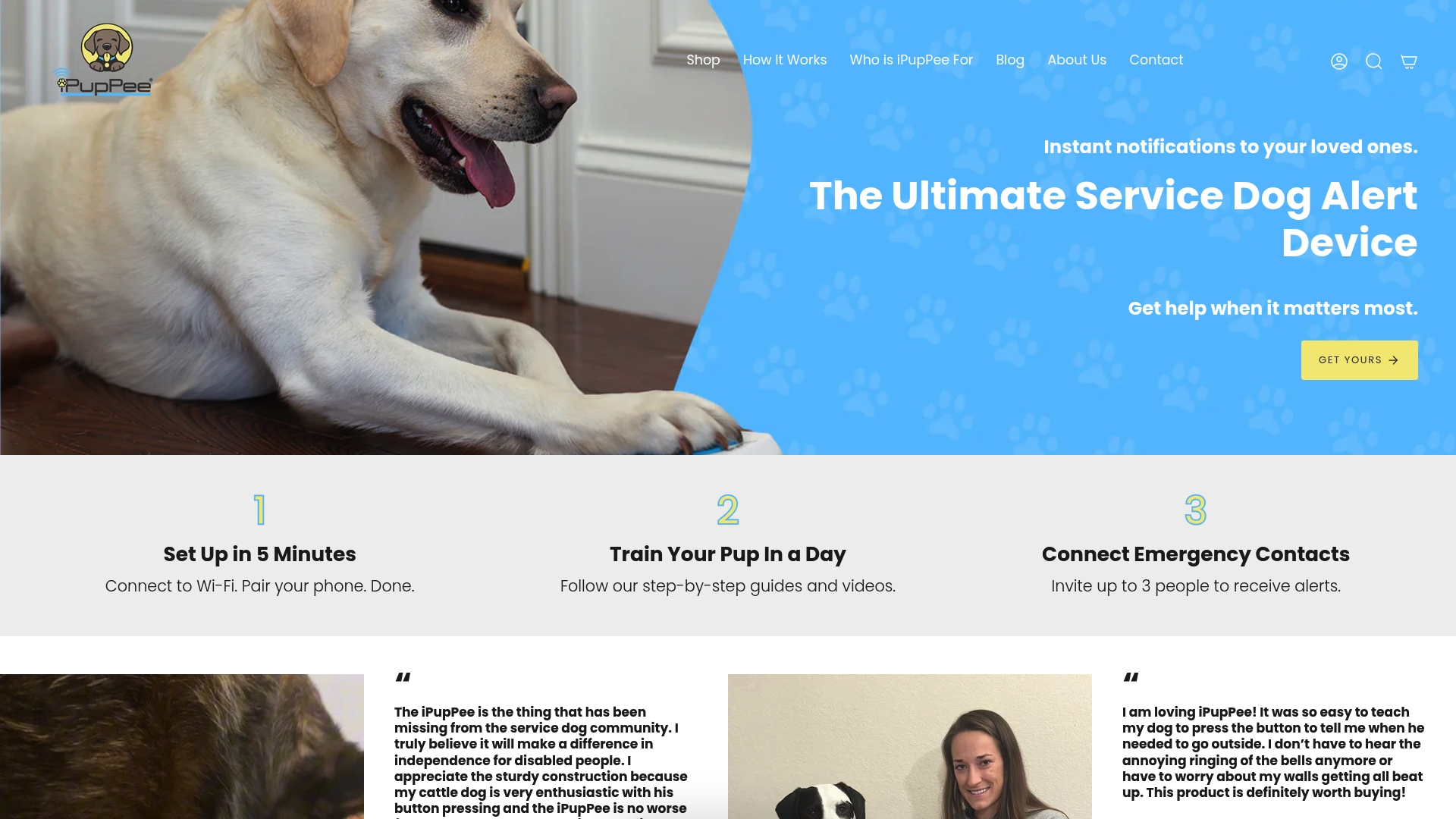
Dog owners love hitting the trails, parks, and lakes with their pups, and over 69 million US households now own a dog. Most think the biggest challenge is keeping their dog on a leash or out of the mud. The real risk is much larger and often invisible, from hidden toxins and wildlife dangers to sudden weather shifts—problems most owners simply do not see coming.
Table of Contents
- Understanding Outdoor Hazards for Dogs
- Preparing Your Dog for Outdoor Adventures
- Special Safety Tips for Service and Senior Dogs
- Emergency Actions and Rescue Readiness
Quick Summary
| Takeaway | Explanation |
|---|---|
| Understand seasonal hazards for dogs. | Be aware of seasonal risks like pesticides and toxic plants that can harm your dog when outdoors. |
| Condition your dog physically for adventures. | Gradually increase your dog’s activity level to build endurance and minimize injury risks during outdoor excursions. |
| Use appropriate safety gear for different environments. | Equip your dog with a harness, reflective items, and protective booties to enhance safety and comfort during outdoor activities. |
| Monitor your dog’s health, especially for seniors. | Regular vet check-ups and awareness of your dog’s physical limits help prevent health emergencies while outdoors. |
| Prepare an emergency kit for outdoor activities. | Assemble a kit with food, water, first aid supplies, and medical records to handle unexpected situations effectively. |
Understanding Outdoor Hazards for Dogs
Dog safety outdoors requires a comprehensive understanding of potential environmental risks that can threaten your canine companion’s well-being. While outdoor adventures offer exciting opportunities for exercise and exploration, they also present numerous challenges that responsible pet owners must carefully navigate.
Seasonal Environmental Threats
Each season brings unique dangers that can compromise your dog’s health and safety. Learn more about seasonal dog protection strategies to minimize risks. According to the ASPCA, springtime introduces specific hazards including pesticide exposure, toxic garden products, and potentially dangerous plants that can cause serious health complications.
Warm weather increases the likelihood of encounters with toxic substances. Pesticides sprayed on lawns, gardens, and public spaces can be particularly dangerous when dogs walk through treated areas and then lick their paws. Chemical residues can cause skin irritation, gastrointestinal distress, and potentially more severe neurological symptoms. Pet owners must be vigilant about checking areas where their dogs play and walk.
Wildlife and Natural Terrain Risks
Outdoor environments host multiple potential dangers beyond chemical exposures. Wild animals like ticks, snakes, and aggressive wildlife can pose significant threats to dogs. Ticks carry diseases such as Lyme disease and Rocky Mountain spotted fever, which can cause long-term health problems if left untreated. Venomous snakes in certain regions can deliver life-threatening bites that require immediate veterinary intervention.
Natural terrain also presents unique challenges. Sharp rocks, broken glass, thorny plants, and uneven surfaces can cause cuts, puncture wounds, or potential injury to a dog’s paws. Dogs with thick fur or those exploring dense vegetation are particularly vulnerable to hidden obstacles that might not be immediately visible.
Temperature and Environmental Exposure Risks
Temperature extremes represent another critical outdoor safety concern. Heat can quickly become dangerous, with surfaces like asphalt reaching temperatures that can burn a dog’s sensitive paw pads in minutes. Dogs are susceptible to heat exhaustion and heatstroke, which can develop rapidly in direct sunlight or high-humidity conditions.
Conversely, cold environments present their own set of risks. Prolonged exposure to freezing temperatures can lead to hypothermia and frostbite, especially for smaller breeds, senior dogs, or those with thin coats. Understanding your dog’s specific environmental tolerance becomes crucial for preventing potential health emergencies.
Responsible dog owners must remain proactive and informed about potential outdoor hazards. Regular veterinary check-ups, understanding your specific environment, and maintaining situational awareness can significantly reduce risks and ensure your canine companion remains safe during outdoor adventures.
To help readers quickly compare outdoor risks, here is a summary table outlining the major types of hazards dogs can face outdoors, along with associated dangers and preventative measures:
| Hazard Type | Example Dangers | Preventative Measures |
|---|---|---|
| Seasonal Hazards | Pesticides, toxic plants | Avoid treated areas; supervise play; educate about local plants |
| Wildlife Risks | Ticks, snakes, aggressive animals | Use tick prevention; leash use; stay on cleared trails |
| Terrain/Environmental Exposure | Sharp rocks, broken glass, thorns | Paw booties; inspect paths; avoid dense vegetation |
| Temperature Extremes | Hot asphalt, heat exhaustion, frostbite | Schedule walks for cooler times; use jackets or vests |
Preparing Your Dog for Outdoor Adventures

Successful outdoor adventures with your dog require thoughtful preparation and strategic planning. Ensuring your canine companion is physically and mentally ready for various environments goes beyond simple excitement for exploration.
Physical Fitness and Health Preparation
Before embarking on any outdoor expedition, a comprehensive health assessment is crucial. Explore our outdoor dog safety guide to understand key preparation steps. According to the UC Davis School of Veterinary Medicine, dogs must be up-to-date on vaccinations, particularly those protecting against environmental threats like leptospirosis. A thorough veterinary check-up will help determine your dog’s fitness level and potential limitations.
Conditioning your dog for outdoor activities involves gradual physical training. Start with shorter walks and progressively increase duration and intensity. Pay attention to your dog’s breed, age, and physical condition. Smaller or senior dogs might require different preparation strategies compared to younger, more athletic breeds. Building endurance prevents exhaustion and reduces injury risks during extended outdoor experiences.
Equipment and Safety Gear
Proper equipment transforms outdoor adventures from potentially risky to thoroughly enjoyable. The American Hiking Society strongly recommends maintaining dogs on a leash during hikes to prevent wildlife disturbances and ensure overall safety. Essential gear includes a sturdy, comfortable harness, reflective accessories for visibility, collapsible water bowls, and a first aid kit designed specifically for canine emergencies.
Consider your specific outdoor environment when selecting gear. For hiking trails, invest in protective booties to shield paw pads from rough terrain. In warmer climates, cooling vests can help prevent overheating. Waterproof jackets provide protection during rainy conditions, while bright colors enhance visibility and safety.
Mental Preparation and Training
Physical readiness means little without proper mental preparation. Training your dog to remain calm and responsive in unfamiliar outdoor settings is fundamental. Practice basic obedience commands in progressively challenging environments. Recreation.gov suggests conducting practice runs by setting up a tent in your backyard and spending a night to assess your dog’s comfort level with new surroundings.
Socialization plays a critical role in outdoor preparedness. Expose your dog to various sounds, textures, and potential distractions before your adventure. This helps reduce anxiety and increases adaptability. Practice recall commands in increasingly distracting environments, ensuring your dog will return promptly when called, even amid exciting outdoor stimuli.
Preparing your dog for outdoor adventures is a holistic process involving physical conditioning, proper equipment, and comprehensive training. By investing time and attention to these critical aspects, you create a foundation for safe, enjoyable experiences that strengthen the bond between you and your canine companion.
To summarize essential outdoor adventure preparation steps for your dog, see the table below:
| Preparation Step | Key Actions |
|---|---|
| Health Check | Up-to-date vaccinations; vet exam; assess activity readiness |
| Physical Conditioning | Start with short walks; gradually increase intensity |
| Equipment & Gear | Harness, leash, reflective gear, paw booties, first aid kit |
| Environment-Specific | Cooling vest for heat; jacket for cold; water bowl for hydration |
| Mental Training | Practice obedience, recall, socialization in varied settings |
Special Safety Tips for Service and Senior Dogs
Service and senior dogs require specialized care and attention during outdoor activities. These unique canine companions face additional challenges that demand a more nuanced approach to safety and outdoor preparation.
Health Monitoring and Physical Limitations
Learn more about service dog care strategies to understand the specific needs of these remarkable animals. According to VCA Animal Hospitals, careful health monitoring becomes crucial for service and senior dogs during outdoor adventures. These dogs often have more limited physical capacities and require extra consideration when planning outdoor activities.
Senior dogs experience reduced mobility, decreased sensory perception, and potential underlying health conditions that impact their outdoor experience. Regular veterinary check-ups become essential to assess their current physical condition and determine appropriate activity levels. Owners must pay close attention to signs of fatigue, discomfort, or potential health complications that might arise during outdoor excursions.
Service dogs present unique challenges due to their specialized training and critical role in supporting their handlers. Their outdoor safety involves protecting both their physical well-being and their ability to perform essential support functions. This requires a delicate balance between maintaining their working capabilities and preventing unnecessary strain.
Environmental Adaptation and Protection
Environmental conditions pose significant risks for service and senior dogs. The Pennsylvania Department of General Services emphasizes the importance of protecting dogs from extreme temperatures. Senior dogs and service dogs with medical conditions are particularly vulnerable to heat stress and cold-related complications.
Specialized protective gear becomes essential for these dogs. This might include cooling vests for hot environments, insulated jackets for cold conditions, and orthopedic support accessories that provide additional comfort during outdoor activities. Breathable materials that offer temperature regulation can help prevent overheating or excessive cooling.
Handlers must develop a keen awareness of their dog’s physical responses to different environmental conditions. This involves monitoring breathing patterns, checking for signs of distress, and being prepared to modify or terminate outdoor activities if the dog shows any signs of discomfort or potential health risks.
Advanced Safety Strategies
The U.S. Forest Service recommends comprehensive preparation for outdoor activities, which becomes even more critical for service and senior dogs. This includes carrying specialized first aid kits, understanding the dog’s specific medical needs, and having a detailed emergency plan.
Technology can play a crucial role in ensuring the safety of service and senior dogs. GPS tracking devices, health monitoring wearables, and communication tools can provide additional layers of protection and real-time health insights. These technologies allow handlers to quickly respond to potential health concerns or unexpected situations.
Ultimately, safety for service and senior dogs requires a holistic approach that combines careful planning, specialized equipment, advanced monitoring, and a deep understanding of the individual dog’s unique needs. By implementing these comprehensive strategies, handlers can ensure their remarkable companions remain safe, comfortable, and capable during outdoor adventures.
Emergency Actions and Rescue Readiness
Emergency preparedness is a critical aspect of responsible dog ownership, particularly during outdoor adventures where unexpected situations can quickly escalate. Understanding how to respond effectively can mean the difference between a minor incident and a life-threatening emergency.
Emergency Preparation and Planning
Preparing for potential emergencies begins long before you step outdoors. Explore our guide on emergency preparedness to develop a comprehensive safety strategy. According to the Centers for Disease Control and Prevention, pet owners should create a detailed emergency kit containing essential supplies such as food, water, medications, first aid items, and important medical documents.
Key components of an emergency preparedness kit include portable water containers, non-perishable food, a compact first aid kit specifically designed for dogs, copies of vaccination records, and a recent photograph of your dog for identification purposes. Consider including a portable battery charger, emergency contact information for veterinarians, and any specific medications your dog requires.
Immediate Response and First Aid Techniques
The American Kennel Club emphasizes the importance of knowing basic first aid techniques and having a clear evacuation plan. This involves understanding how to assess your dog’s condition, perform basic medical interventions, and recognize signs of serious health emergencies.
Critical first aid skills include checking vital signs, controlling bleeding, treating shock, managing heat exhaustion, and performing canine CPR. Owners should invest time in professional training courses that teach these essential skills. Learning how to create a makeshift muzzle, improvise splints, and conduct emergency wound care can be lifesaving in remote or challenging outdoor environments.
Advanced Rescue and Communication Strategies
Effective communication and tracking become paramount during outdoor emergencies. Modern technology offers numerous tools to enhance dog safety and rescue capabilities. GPS tracking devices, emergency communication systems, and wearable health monitors can provide critical information during unexpected situations.
Develop a comprehensive communication plan that includes:
- Emergency contact lists with local veterinarians
- Detailed information about your dog’s medical history
- Identification tags with current contact information
- Microchip registration with up-to-date contact details
Training your dog in basic emergency commands can significantly improve rescue efforts. Teaching reliable recall, staying calm during stressful situations, and responding to specific emergency signals can help maintain control and facilitate quicker rescue operations.
Ultimately, emergency readiness is about anticipation, preparation, and rapid, informed response. By developing a comprehensive strategy that combines advanced planning, medical knowledge, and technological support, dog owners can dramatically improve their ability to protect and rescue their canine companions during outdoor adventures.
To assist readers in assembling a canine outdoor emergency kit, here is a checklist table covering recommended supplies:
| Emergency Kit Item | Purpose | Included? |
|---|---|---|
| Portable water container | Hydration during outings | |
| Non-perishable dog food | Nutrition in case of extended emergency | |
| Canine first aid kit | Immediate medical care | |
| Vaccination records | Proof of immunizations for emergencies | |
| Recent dog photo | Identification in case your dog is lost | |
| Emergency contact info | Quick access to vets/assistants | |
| Essential medications | Maintain dog’s health |

Frequently Asked Questions
What are the main outdoor hazards for dogs?
Outdoor hazards for dogs include seasonal risks like pesticide exposure, wildlife dangers such as ticks and snakes, and environmental challenges like temperature extremes and rough terrain.
How can I prepare my dog for outdoor adventures?
To prepare your dog for outdoor adventures, ensure they are physically fit through conditioning, equip them with appropriate safety gear, and provide mental training to handle new environments.
What special safety considerations are there for senior or service dogs?
Senior and service dogs may have physical limitations and require special monitoring for health issues. Providing protective gear, ensuring moderate activity levels, and keeping an eye on their comfort in different environments is crucial.
What should I include in an emergency kit for dogs?
An emergency kit for dogs should include portable water, non-perishable food, a canine first aid kit, vaccination records, a recent photo of the dog for identification, and emergency contact information for veterinarians.
Protect Your Dog with Smarter Communication Outdoors
Outdoor risks can be unpredictable, from sudden wildlife threats to medical emergencies far from help. In the article, you learned how quickly things like environmental hazards, heat stress, or unexpected injuries can put your dog in danger—especially when exploring new places. But you do not have to face these worries alone. Smart, reliable dog communication can give you peace of mind while enhancing your dog’s independence and safety.

See how the iPupPee alert device can change outdoor safety for good. This innovative solution allows your dog to instantly alert you in case of a problem with a single button press. Whether you have a service dog, a playful puppy, or a senior companion, early communication could be the difference in an emergency. Learn the benefits, view real customer stories, and discover why dog owners across the country trust ipuppee.com to keep their pets safer outdoors. Take the first step toward greater peace of mind today—visit our product page for more details and training resources.
Recommended
-
https://ipuppee.com/blogs/news/best-hiking-trails-to-bring-your-dog-in-the-us)
-
https://ipuppee.com/blogs/news/traveling-with-your-dog-tips-for-a-smooth-journey)
-
Pet Safe Pest Prevention Tips - Pest Control Van Alstyne, TX - Pestico Pest Control
-
Pet Care When on Vacation: Best Tips for 2025 - Pet Care with Love

